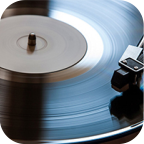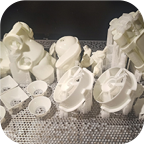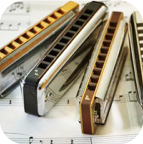Should You Use an Ultrasonic Cleaner for Your Retainer?
Browse Volume:4 Classify:Support
If you wear a retainer daily, you’re essentially placing a bacteria magnet into your mouth every time you snap it in. Over the course of just a few hours, your retainer collects saliva, plaque, food particles, and bacteria from every surface it touches—your tongue, teeth, gums, and even the air around you. And unlike your teeth, which get brushed twice a day, retainers are often neglected or only casually rinsed under the tap.
The result? A build-up of biofilm, which is a sticky layer of bacteria that hardens over time. Left unchecked, this biofilm not only causes discoloration and odor but also introduces potential health risks, including gum irritation, bad breath, and even minor infections. According to a study published in the Journal of Orthodontic Science, retainers harbor several strains of bacteria and yeast if not cleaned effectively, including Candida albicans and Streptococcus mutans, both of which are implicated in oral diseases.
For many people, a retainer becomes part of daily life—worn overnight, stored in pockets or cases during meals, and returned to the mouth without a second thought. This casual routine opens the door for long-term hygiene issues. Over time, a dirty retainer can undo some of the progress made by orthodontic treatment, especially if inflammation around the gums starts to develop.
But here’s the real catch: not all cleaning methods are created equal. Rinsing with water or even brushing with toothpaste can leave behind debris and bacteria in microscopic grooves or crevices. And depending on the material of the retainer, improper cleaning could do more harm than good—scratching the surface or degrading the plastic.
That’s why the question of whether ultrasonic cleaners are good for retainers has become increasingly relevant. As more people invest in orthodontic care and search for efficient hygiene routines, ultrasonic cleaning stands out as a promising, high-tech option worth investigating.
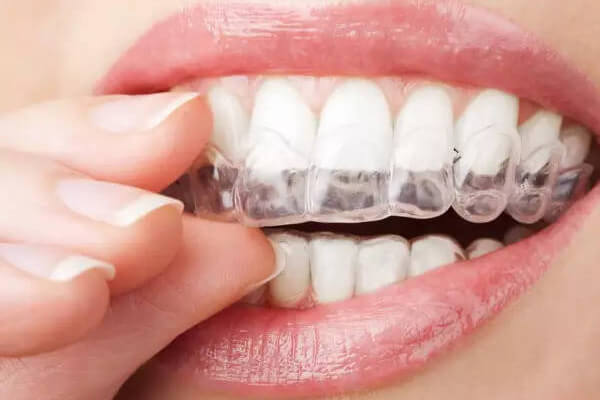
Braces
Before we evaluate whether an ultrasonic cleaner is the best tool for the job, it’s important to understand how people have traditionally cared for their retainers—and where those methods fall short.
Traditional Methods of Cleaning Retainers
For decades, people have cleaned their retainers using the same basic tools they use for their teeth: toothbrushes, toothpaste, and tap water. While this method seems logical because it is simple, quick, and requires no extra products, it is not always effective or safe for the retainer’s material. In fact, the abrasive particles in toothpaste can cause microscopic scratches in clear plastic retainers, making them look cloudy and feel rough over time. These tiny scratches also create places for bacteria to cling and multiply, making the retainer harder to clean with each use.
Another popular method involves soaking retainers in mouthwash. While it may leave a fresh taste, many mouthwashes contain alcohol or strong chemicals that can dry out or warp plastic materials over time. Repeated exposure may reduce the flexibility of a retainer, or even cause small fractures in the long run. Additionally, mouthwash alone doesn’t fully break down proteins, plaque, or hardened debris stuck in corners or crevices.
Cleaning tablets are another go-to solution. These are typically effervescent tablets dropped into a glass of water, releasing fizz and mild cleansing agents designed to remove debris and bacteria. Products like Retainer Brite and Polident are widely used and more effective than brushing alone. However, they still have limitations. While the fizzing action can loosen buildup, these solutions don’t always reach every crevice or fully sanitize a retainer, especially if it’s worn nightly for long periods. Moreover, some users experience allergic reactions to the additives or flavorings in tablet-based cleaners.
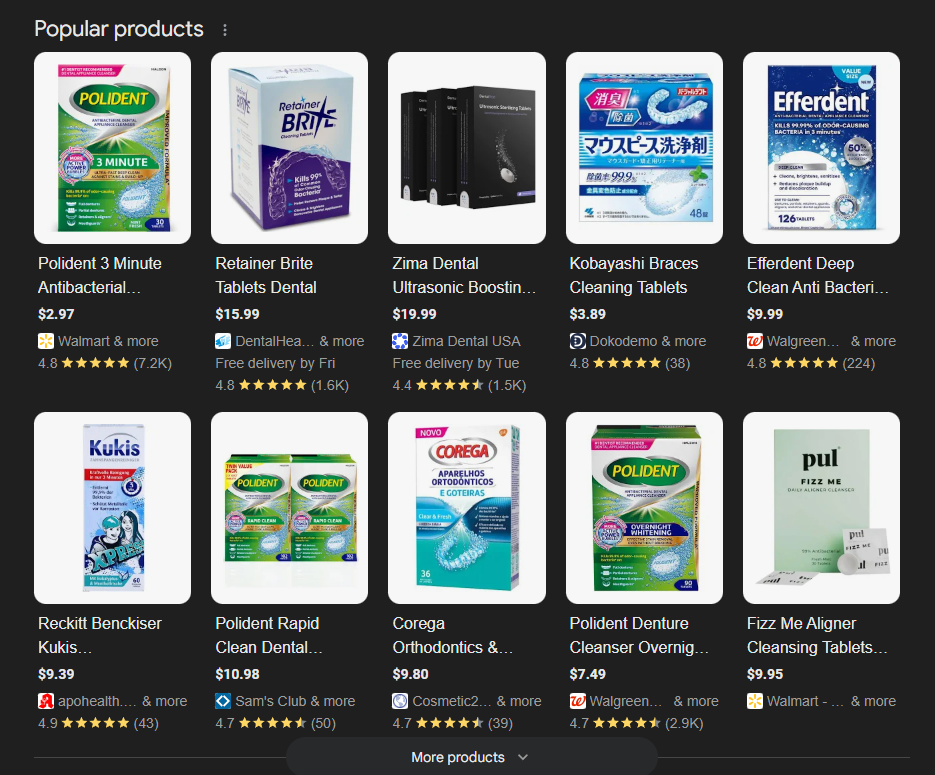
Braces cleaning tablets
Some individuals, perhaps in desperation, turn to boiling their retainers. This is almost always a mistake. Heat is a known enemy of most orthodontic appliances. Boiling water can cause plastic retainers to deform or warp, ruining their fit. Even warm water left too long can soften thermoplastics and compromise the device. Once a retainer is out of alignment, it can no longer serve its orthodontic purpose and might even cause damage to your bite.
Other DIY methods include vinegar solutions, hydrogen peroxide soaks, or baking soda pastes. While these household ingredients can offer mild cleaning effects, they’re often inconsistent and not always safe. Vinegar, for instance, may remove some mineral deposits, but its acidic nature can degrade soft plastics and leave behind a strong odor. Hydrogen peroxide has antibacterial properties, but it doesn’t break down proteins well and can bleach or dry out material if used excessively.
Overall, while these traditional methods can provide short-term cleanliness or cosmetic improvement, they fall short when it comes to long-term hygiene, safety, and efficiency. For people who wear retainers daily, especially overnight, relying solely on these options may not be enough.
That’s where ultrasonic cleaning enters the picture. But before exploring its pros and cons, we need to understand what an ultrasonic cleaner actually does—and why it’s gaining traction in orthodontic care.
What Is an Ultrasonic Cleaner?
Ultrasonic cleaners may sound like something out of a dental lab or jewelry store, but they’re becoming increasingly popular for at-home use, especially among people who want a deeper clean for personal items like retainers, aligners, and dentures. But what exactly makes ultrasonic cleaning different from soaking or scrubbing?
At its core, an ultrasonic cleaner is a device that uses high-frequency sound waves, usually between 20 kHz and 200 kHz, to agitate a liquid. When a retainer or other item is placed into the tank, which is typically filled with water or a mild cleaning solution, the ultrasonic transducer emits sound waves into the fluid. These waves generate microscopic bubbles through a process known as cavitation.
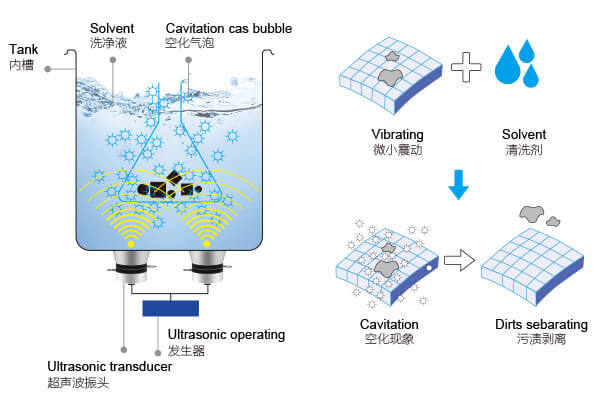
The Principle Behind Ultrasonic Cleaning
Now, these aren’t ordinary bubbles. Cavitation bubbles rapidly form and collapse, producing intense localized energy. As they burst near the surface of a retainer, they dislodge even the most stubborn particles such as tiny food residues, hardened plaque, or bacterial film hiding in grooves and along wires. This microscopic scrubbing effect happens thousands of times per second, reaching into places a toothbrush or cleaning tablet simply cannot access.
Importantly, the cleaning action is non-abrasive. Because it relies on sound waves and liquid movement rather than physical friction, ultrasonic cleaning does not scratch or erode materials when used correctly. This makes it especially useful for delicate or complex items like a retainer, which may include fine wires, pressure-formed plastic, or other vulnerable components.
Modern ultrasonic cleaners for home use typically include a stainless steel tank, a digital control panel, and preset cycles ranging from 3 to 15 minutes. Some models even allow users to adjust the frequency, power, or temperature. However, for cleaning retainers, cold or room-temperature water is usually recommended to avoid warping sensitive plastic.
One of the key advantages of ultrasonic cleaning is its consistency. Unlike brushing or soaking, which may vary depending on how long or how vigorously someone cleans, an ultrasonic cycle delivers the same intensity and coverage every time. This can make a noticeable difference for users who prioritize hygiene but do not have the time or desire to manually scrub their retainers daily.
Ultrasonic cleaners are already used extensively in dental offices, where hygiene is non-negotiable. Instruments, drills, and orthodontic tools often undergo ultrasonic cleaning before being sterilized. The technology has a proven track record in removing organic debris and fine contaminants, which is part of the reason it has found its way into consumer homes.
But knowing how ultrasonic cleaners work is only half the picture. The real question is: are they truly good for retainers? Do they offer practical, safe, and long-term benefits, or are they just another gadget?
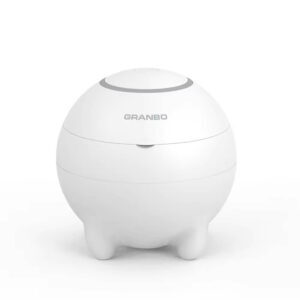
UV Ultrasonic Cleaner for Dental Appliances – 360° Deep Clean for Dentures, Jewelry & Household Items, 48kHz Frequency, 3 Modes
Are Ultrasonic Cleaners Good for Retainers?
The short answer is yes—ultrasonic cleaners can be very good for retainers, provided they are used correctly and with the right equipment. But to truly understand their value, we need to look beyond convenience and explore how they interact with retainer materials, what experts say, and what real users experience.
Retainers, whether made of clear thermoplastics like Essix or traditional acrylic and wire like Hawley models, are prone to the same problem: they collect debris and bacteria in hard-to-reach areas. Between the tight grooves where plastic meets tooth impressions and the junctions between wires and acrylic, bacteria thrive. This is where ultrasonic cleaners show their strength. Instead of relying on a toothbrush’s reach or a soaking tablet’s surface action, ultrasonic waves penetrate every curve, dip, and contour. The cavitation bubbles generated in the cleaning bath are small enough to reach into spaces that no bristle or cotton swab can access.
A 2018 study published in the Journal of Orthodontic Research compared multiple retainer cleaning methods. The researchers tested brushing, soaking in commercial tablets, and ultrasonic cleaning, both with and without added disinfectant. The ultrasonic cleaner outperformed all other methods in removing plaque biofilm and reducing bacterial load—especially when used with a retainer-safe enzymatic solution. This reinforces what many orthodontists have started to recommend: ultrasonic cleaning is one of the most effective non-invasive ways to keep a retainer hygienic.
Dentists and orthodontists are also beginning to embrace ultrasonic cleaning as a safer alternative to harsh chemicals or abrasive cleaning tools. While bleach, vinegar, or peroxide can irritate gums or damage plastics over time, ultrasonic cleaning works purely through mechanical vibration, not chemical reaction. When paired with a mild cleaning solution or just distilled water, the process becomes both gentle and thorough.
Users often report noticeably fresher-smelling retainers, improved clarity in transparent models, and a reduction in plaque buildup after just a few cleaning cycles. For many, the shift to ultrasonic cleaning eliminates the need for frequent scrubbing and reduces the wear and tear on retainers caused by friction-based cleaning.
However, it’s important to recognize that not all ultrasonic cleaners are created equal. A low-power, poorly manufactured unit may not generate strong enough cavitation to clean effectively. Conversely, an overly powerful cleaner or one used with hot water could potentially damage delicate retainers if misused. This makes it essential to select a device designed for dental or personal care applications and to always follow the recommended cycle durations and temperatures.
The material of your retainer also plays a role. Acrylic, wire, and medical-grade thermoplastics generally hold up well under ultrasonic cleaning. That said, retainers with glued-in components, like fixed lingual retainers, may require special caution depending on how they’re bonded.
Used correctly, ultrasonic cleaners provide a powerful, safe, and professional-grade cleaning method for all types of removable retainers. They’re not just good; they’re often better than anything you could do by hand at home.
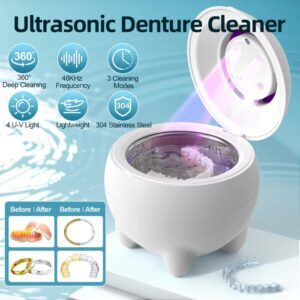
Ultrasonic Denture cleaner
Which Types of Retainers Are Safe for Ultrasonic Cleaning?
Not all retainers are built the same, and that matters greatly when you’re considering ultrasonic cleaning. The material and structure of your retainer will determine whether ultrasonic vibration enhances hygiene—or poses a risk. To get the most out of this technology without compromising your orthodontic investment, it’s crucial to understand what’s safe and what’s not.
Let’s begin with the most common categories of retainers: Essix, Hawley, and fixed (bonded) retainers.
Essix retainers, often referred to as clear or invisible retainers, are made from medical-grade thermoplastic. These are molded to fit over your teeth like a thin, transparent shell—much like Invisalign trays. Because of their smooth surfaces and precision-molded shapes, Essix retainers are particularly well-suited for ultrasonic cleaning. The plastic is strong enough to withstand the vibrations, and the cleaner can reach into the fine tooth impressions where plaque often collects. As long as the cleaning solution is appropriate (non-corrosive and non-acidic), ultrasonic cleaning is not only safe for Essix retainers—it can help extend their life by reducing manual wear.
Hawley retainers are the traditional wire-and-acrylic models that most people associate with post-braces maintenance. These have a sturdy acrylic plate that sits along the roof of the mouth or behind the lower teeth, with metal wires that wrap around the front teeth to hold them in place. The acrylic portion is dense enough to tolerate ultrasonic cleaning, and the metal components are usually made from stainless steel, which is corrosion-resistant. That said, the wires may have soldered joints, and these could weaken over time if exposed to aggressive ultrasonic cycles or unsuitable cleaning solutions. To stay safe, it’s best to limit the cleaning time to 5–10 minutes, use room temperature water, and avoid harsh detergents.
Bonded or permanent retainers are a different story. These are thin metal wires cemented to the back of the teeth, usually in the lower front arch. Because they are not removable, they cannot be placed in an ultrasonic bath without the user being attached—which is obviously not an option. For these types of retainers, ultrasonic cleaning can only be performed in a dental office using specialized tools. Home users should focus on flossing aids and regular dental cleanings instead.
Other specialty retainers, such as dual-layer night guards (which may have both soft and hard materials) or orthodontic positioners, should be evaluated on a case-by-case basis. If your appliance includes flexible plastic, colored components, or embedded electronics (such as RFID tags in some modern devices), ultrasonic cleaning may be risky. Always consult with your orthodontist or retainer manufacturer before placing these into an ultrasonic cleaner.
A good rule of thumb is this: if your retainer is removable, solid (not layered), and made of either hard plastic or stainless steel wire, it’s likely safe for ultrasonic cleaning when used responsibly. But if it contains adhesives, coatings, or temperature-sensitive materials, you’ll need to proceed with extra caution or avoid ultrasonic cleaning altogether.
The Benefits of Using Ultrasonic Cleaners for Retainers
Switching from manual cleaning methods to an ultrasonic cleaner can feel like upgrading from a flip phone to a smartphone. It’s not just a slight improvement—it’s a dramatic enhancement in cleanliness, consistency, and peace of mind. Let’s break down the real, practical benefits that users and professionals experience when using ultrasonic cleaners for retainer care.
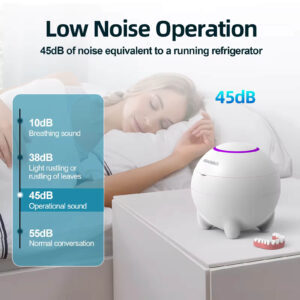
Low Noise Operation
45dB of noise equivalent to a running refrigerator
1. Deep Cleaning in Hard-to-Reach Areas
The number one advantage is depth. Cavitation—the formation and collapse of microscopic bubbles—isn’t limited by angles, reach, or dexterity. It gets into every nook and cranny, from the inner grooves of Essix retainers to the delicate wire-acrylic junctions of Hawley retainers. This is something even the most thorough brushing can’t replicate.
For anyone who has ever struggled to remove a white calcium deposit or a lingering patch of hardened plaque near a wire, the effectiveness of ultrasonic cleaning becomes obvious after just one cycle. You’ll often see the cloudy buildup vanish, revealing the clear or glossy surface underneath.
2. Odor Reduction
Retainers are exposed to all kinds of bacteria, food particles, and dry mouth conditions—factors that lead to unpleasant smells. Even after brushing, some of that odor can linger. Ultrasonic cleaners neutralize much of that by dislodging odor-causing bacteria, not just masking it. Many users report that their retainers feel fresher and taste cleaner after regular ultrasonic use, especially when combined with a safe cleaning solution.
3. Less Manual Scrubbing, Less Wear
Toothpaste and brushes can scratch the surface of thermoplastic retainers, leaving them looking hazy or cloudy over time. These scratches not only reduce clarity but also make the surface more hospitable to bacteria. With ultrasonic cleaning, you eliminate the need for abrasive tools. The process is hands-free and uniform, preserving the integrity and clarity of the material while still achieving excellent results.
4. Time-Saving and Convenient
Most ultrasonic cycles take between 3 and 10 minutes. That’s time you can spend doing anything else—making coffee, brushing your teeth, or getting dressed—while your retainer is being cleaned thoroughly. For people with busy schedules or limited patience for daily retainer care, this convenience alone is a game-changer.
5. Consistency and Hygiene Control
Unlike brushing, which depends on how much pressure you apply or how much time you spend, ultrasonic cleaning delivers consistent results every time. Whether it’s day one or day one hundred, the device will clean your retainer with the same intensity and coverage, assuming proper settings and solution are used. This predictability is particularly valuable for people prone to plaque buildup or recurring mouth irritation.
6. Longer Retainer Lifespan
When retainers are cleaned gently and effectively, they tend to last longer. Excessive scrubbing, boiling, or exposure to harsh chemicals can shorten their usable life. With ultrasonic cleaning, you reduce the stress on the material while maintaining a high standard of hygiene. Over the years, that translates to fewer replacements and better orthodontic outcomes.
7. Ideal for People with Dental Sensitivities
If you have sensitive gums, dry mouth, or are recovering from oral surgery, minimizing physical contact with your appliance can help reduce irritation. Ultrasonic cleaning is non-contact and non-invasive, making it a gentler option for maintaining hygiene without triggering gum soreness or bleeding.
All of these benefits come together to form a clear picture: ultrasonic cleaners aren’t just “good enough” for retainers—they’re often the best option for maintaining them safely, effectively, and effortlessly.
However, even the best tools come with a few caveats. Before you drop your retainer into the tank and hit the start button, you need to understand the potential risks and how to avoid them.
Potential Risks and What to Avoid
Despite the many benefits of ultrasonic cleaning, it’s not a perfect one-size-fits-all solution. Like any powerful tool, when used incorrectly—or paired with the wrong materials—an ultrasonic cleaner can cause unintended damage to your retainer. That’s why understanding the potential risks and how to avoid them is essential for safe, long-term use.
1. Heat Sensitivity and Warping
One of the biggest concerns with using ultrasonic cleaners for retainers, especially those made from thermoplastics like Essix, is the potential for heat damage. Some ultrasonic units come with heating elements, designed to improve cleaning for industrial or metal parts. However, retainers do not require heat to be cleaned effectively. In fact, heat above 40°C (104°F) can soften or distort plastic materials, making your retainer lose its precise fit.
If your cleaner has a built-in heater, always ensure it’s turned off—or set the temperature to “room temperature only.” Cleaning in warm water for extended periods can cause warping that is often irreversible.
2. Using Harsh or Incompatible Cleaning Solutions
The cleaning solution you use matters just as much as the machine itself. Household cleaners like bleach, ammonia, or vinegar may seem tempting for their disinfecting properties, but they can damage both the retainer and the ultrasonic unit.
Vinegar is acidic and can degrade plastics. Bleach is corrosive and can weaken both plastic and metal components. Even hydrogen peroxide, if used regularly at high concentrations, can dry out or yellow clear retainers over time.
To stay safe, stick to solutions specifically formulated for dental appliances or mild mixtures of water with a drop of unscented liquid dish soap. Some enzymatic cleaners designed for dentures or aligners also work well with ultrasonic baths, provided they are approved for your retainer material.
3. Over-Cleaning or Excessive Cycle Time
While it’s tempting to run multiple cycles to achieve a “sparkling” clean, over-cleaning can degrade retainers over time. This is especially true for delicate wires, soldered joints, or thin plastic shells. A single cycle of 5–10 minutes is usually sufficient for routine cleaning. More than one cycle per day is rarely necessary unless your retainer has visible buildup or hasn’t been cleaned in several days.
4. Damage to Soldered or Glued Areas
For Hawley retainers or other appliances that include bonded elements—like metal joints or acrylic adhesives—aggressive ultrasonic cleaning may loosen or stress those connections over time. It doesn’t happen immediately, but repeated daily exposure, especially with high-power units, could shorten the appliance’s lifespan. If your retainer includes glued or soldered parts, use shorter cycles and check regularly for signs of loosening.
5. Not Rinsing Thoroughly After Cleaning
Any cleaning solution, no matter how mild, should be thoroughly rinsed off your retainer after the ultrasonic cycle. Residual chemicals can cause gum irritation or leave an unpleasant taste. Always rinse the retainer with cool, clean water and let it air-dry completely before wearing it again or storing it in a closed case.
6. Misuse of the Ultrasonic Device
Lastly, some users forget that ultrasonic cleaners themselves require care. Overfilling the tank, operating without liquid, or placing items directly on the metal base without a basket can damage both the retainer and the device. Always use the included basket or tray to suspend your retainer in the liquid. And follow your unit’s instructions carefully to avoid internal damage or inefficient cleaning.
With these risks in mind, ultrasonic cleaners remain a powerful and safe tool for retainer care—when used responsibly. The next question, though, is what exactly should you put into that tank to get the best results?
What to Put in an Ultrasonic Cleaner for Retainers
The cleaning solution you use in your ultrasonic cleaner plays a major role in determining how effective—and safe—the process will be for your retainer. Just filling the tank with tap water might give you a basic level of cleanliness, but for truly effective hygiene, a thoughtful approach to the cleaning solution is essential.
Start With Distilled Water
Always begin with distilled water rather than tap water. Tap water contains minerals that can leave behind residue or scaling, especially on clear Essix retainers. Over time, this can cause cloudiness or deposits that are hard to remove. Distilled water ensures a clean, neutral base and prevents buildup on both the retainer and the ultrasonic unit itself.
Mild Liquid Dish Soap (Non-Antibacterial, Unscented)
For most day-to-day cleaning, a drop of unscented, non-antibacterial dish soap added to the distilled water is more than sufficient. It provides enough surfactant to help loosen debris and break the surface tension of water, enhancing the cavitation process. Avoid scented or colored soaps, as they may contain additives or dyes that cling to the retainer’s surface or irritate the gums.
Retainer-Specific Cleaning Tablets
Many orthodontists recommend using a retainer-safe effervescent tablet once or twice a week in conjunction with ultrasonic cleaning. Brands like Retainer Brite, Smile Saver, or Invisalign Cleaning Crystals are formulated for dental plastics and won’t degrade the materials. When used in small concentrations in an ultrasonic bath, these tablets can boost the cleaner’s effectiveness, especially for tough buildup or odor.
However, always read the manufacturer’s directions. Some tablets are designed for passive soaking only and may foam too much when agitated ultrasonically. Using too much cleaner or mixing incompatible products could damage the machine or the retainer.
Enzymatic Cleaning Solutions
These are a step up from basic soap or tablets. Enzymatic cleaners contain biological agents that break down proteins, plaque, and saliva more efficiently. Dental offices frequently use these in ultrasonic baths for instruments, and many over-the-counter versions are now available for home use. Look for products labeled as safe for aligners or dentures, and ensure they are alcohol-free and pH-balanced.
Avoid These Common Mistakes
- Vinegar: Though popular in DIY cleaning circles, vinegar is acidic and can weaken retainer plastic or discolor wire components. It also leaves a strong smell.
- Baking Soda: While it may be safe in small amounts, it can be abrasive and tends to settle at the bottom of the tank, reducing cavitation efficiency.
- Bleach or Hydrogen Peroxide: These are too harsh for retainers. They may damage the finish, irritate oral tissue, and degrade components with repeated use.
The Right Ratio and Procedure
For daily cleaning, fill the tank with distilled water and add one small drop of dish soap or follow the dilution instructions of your chosen cleaning product. Never exceed the recommended concentration. Place the retainer in the basket, start the ultrasonic cycle for 5–10 minutes, then remove, rinse thoroughly with cool water, and let air-dry.
Step-by-Step Guide to Cleaning a Retainer in an Ultrasonic Cleaner
Cleaning your retainer with an ultrasonic cleaner doesn’t require technical expertise—but doing it correctly ensures you get the best results without damaging your appliance. Here’s a simple, safe, and effective step-by-step routine that orthodontists and dental hygienists would approve of.
Step 1: Prepare Your Equipment
Begin by making sure your ultrasonic cleaner is clean and free of residue from previous use. Rinse out the tank with distilled water if needed, and ensure that the removable basket (if included) is seated properly inside.
Step 2: Add the Cleaning Solution
Fill the tank with distilled water to the indicated fill line. If you’re using a cleaning additive, add only the recommended amount. For daily use, this might be a single drop of mild dish soap or a small amount of a retainer-safe enzymatic solution. Do not overfill or add incompatible chemicals like bleach or alcohol-based liquids.
Step 3: Place the Retainer in the Basket
Always place the retainer in the included basket or tray—never let it rest directly on the bottom of the tank. Direct contact with the transducer plate can lead to vibration damage over time. Position the retainer so it’s fully submerged and not touching other objects.
Step 4: Set the Timer and (If Available) Disable Heat
For most retainers, a cleaning cycle of 5 to 10 minutes is ideal. If your ultrasonic cleaner has a heating function, make sure it is turned off. Excessive heat can warp plastic or loosen adhesives in multi-component retainers.
Step 5: Run the Cleaning Cycle
Start the ultrasonic cycle and let the machine do its work. You may notice tiny bubbles rising from the retainer surface—this is cavitation in action. During the cycle, resist the urge to open the lid or adjust the device unless necessary.
Step 6: Remove and Rinse Thoroughly
Once the cycle is complete, lift the basket and carefully remove the retainer. Rinse it under cool, running water for 15 to 30 seconds to remove any residual cleaning solution or loosened debris. Inspect the retainer for any remaining buildup.
Step 7: Air Dry and Store Properly
Let your retainer air-dry on a clean towel or vented tray. Avoid drying with tissue or cloths that may leave fibers behind. Once dry, store it in a ventilated case if not worn immediately. Avoid sealing it in a damp or airtight container.
Step 8: Clean the Ultrasonic Device
After every few uses, rinse the tank and wipe it dry to prevent mineral buildup or bacterial growth. If you’re using any cleaning solution beyond water and soap, make sure the tank is thoroughly rinsed after each cycle to protect the transducer and internal components.
Frequency of Cleaning
If you wear your retainer daily, an ultrasonic cleaning once a day or every other day is ideal. On non-ultrasonic days, you can rinse it with water or do a quick brush with a soft toothbrush and no toothpaste. Weekly or bi-weekly deep cleaning with tablets or enzymatic solution provides even more protection against buildup.
By following this routine, you ensure that your retainer remains clean, odor-free, and structurally sound for as long as possible—without unnecessary wear and tear.
Comparing Home Ultrasonic Cleaners vs. Professional Dental Models
Ultrasonic cleaners used in dental clinics and orthodontic offices often look similar to consumer models at first glance—but the differences under the hood can be significant. If you’re considering investing in a unit for at-home retainer care, it’s helpful to understand how home devices compare to their professional counterparts and which features actually matter for everyday use.
Power and Frequency Differences
One of the most important distinctions lies in power output and frequency range. Professional dental ultrasonic cleaners typically operate at a consistent frequency, such as 40 kHz, and have higher wattage for stronger cavitation. This gives them more cleaning power, allowing them to handle blood, tissue residue, and complex surgical tools that need pre-sterilization cleaning.
Home ultrasonic cleaners, on the other hand, usually operate between 40–45 kHz with moderate power—ideal for consumer use. For retainers, this is not a drawback. In fact, a lower-power machine is gentler on delicate materials like thermoplastic and soldered wire. Higher frequencies (above 80 kHz) are used in labs for cleaning ultra-delicate items like microelectronics or thin-film coatings, which aren’t necessary for orthodontic appliances.
In short, more power isn’t always better for your retainer. For most users, a mid-frequency machine around 40 kHz with 30–50 watts of power is more than sufficient.
Size and Capacity
Professional models tend to be larger, designed to hold multiple tools, dental molds, or even entire surgical kits. They often require more counter space and use more fluid per cycle.
Home models are compact, often between 300 mL to 800 mL in capacity—just enough for a retainer or small mouthguard. Some units include a basket or tray that keeps the retainer suspended in liquid without touching the metal base, which is ideal.
Unless you’re cleaning multiple devices or plan to use the cleaner for other items like dentures or jewelry, there’s no need to purchase a bulky professional-grade unit for home use.
Control Features and Customization
Professional machines typically offer precise settings for temperature, frequency, power level, and cycle duration. They may have digital timers, memory functions, and safety shut-offs.
While home ultrasonic cleaners are simpler, many now come with useful features like digital timers (3, 5, or 10 minutes), degas modes (for eliminating trapped air), and auto shut-off. These functions are more than adequate for retainer care.
A key point to consider is the presence of a heating element. While heat helps clean metal tools, it’s generally not recommended for retainers. Many home models allow you to disable heating, but some lower-end units do not. Always verify this before buying.
Cost Comparison
Professional ultrasonic cleaners can cost several hundred to over a thousand dollars, depending on their capacity and features. They’re designed for heavy-duty, all-day use and sterilization prep.
Home units range from $30 to $150, depending on the brand and functionality. For retainer users, even a $60–80 unit with decent build quality and frequency control can provide years of reliable service.
Durability and Maintenance
Commercial-grade machines are built for longevity and high throughput. However, well-maintained home models can last for many years when used correctly and cleaned regularly.
For most retainer wearers, a mid-tier home ultrasonic cleaner strikes the perfect balance between cost, convenience, and performance. You won’t need industrial-grade features to maintain oral hygiene—just the right frequency, a gentle cycle, and some basic best practices.
Testimonials and Real-World Experience
While clinical studies and expert recommendations provide strong evidence in favor of ultrasonic cleaning, sometimes the most convincing insights come from the people who use these devices every day. Retainer wearers—from teenagers to adults in long-term orthodontic treatment—often share their experiences online and in dental forums, offering practical, no-nonsense feedback that reflects real-life use.
“My Retainer Looks Brand-New Again”
One common sentiment among first-time ultrasonic cleaner users is surprise at how much cleaner their retainer appears after a single cycle. Clear Essix retainers, which tend to accumulate a foggy layer over time, are often reported to return to their original clarity. As one Reddit user wrote in the r/Dentistry forum:
“I thought my retainer was just permanently cloudy. Turns out it was just buildup I couldn’t remove by brushing. The ultrasonic bath cleaned it in under 10 minutes—it looks brand new again.”
Another reviewer on a dental appliance cleaning blog noted that years of brushing failed to remove certain deposits that the ultrasonic cleaner handled with ease.
“No More Morning Breath”
Many users also report a noticeable difference in the way their retainers smell and feel after ultrasonic cleaning. Since biofilm and bacteria are major contributors to oral odor, reducing these through cavitation can help eliminate what many call “morning retainer breath.”
“I used to wake up with that nasty taste in my mouth even after brushing at night. Since using an ultrasonic cleaner daily, I’ve noticed a real change in freshness—not just of the retainer, but my whole mouth.”
– Verified buyer on a health products website
“My Orthodontist Noticed the Difference”
In some cases, patients share that their orthodontists or dentists actually commented on how clean their retainers looked at routine visits. That level of cleanliness isn’t just aesthetic—it can also prevent gingivitis, irritation, or damage caused by plaque-laden appliances.
“At my last appointment, my orthodontist asked how I kept my retainer so clean. I told her about the ultrasonic cleaner, and she said she’s going to start recommending them to other patients.”
– User comment from a dental care forum
“A Game-Changer for Busy Schedules”
Working professionals, students, and parents especially appreciate the convenience factor. Many of them mention how the ultrasonic cleaner helped them stick to a better cleaning routine because it required less effort.
“I barely have time in the morning, so I just drop my retainer in the cleaner while I shower and get ready. It’s hands-off, and it does a better job than I ever could manually.”
– Amazon customer review
Common Complaints: Mostly User Error
The few negative experiences usually come down to incorrect usage. Some people damaged their retainers by using hot water or harsh chemicals, while others bought overly cheap units that didn’t generate sufficient cavitation.
“The first one I bought didn’t work at all—it was basically a vibrating bowl. Then I got one with better specs and it made a huge difference. Quality matters.”
– Product review comparison on YouTube
Overall, the consensus is clear: when used properly, ultrasonic cleaners are a practical, reliable, and safe way to care for retainers. But is it truly the best option for everyone?
Final Thoughts: Are They Worth It for Daily Retainer Care?
Ultrasonic cleaners are not just a modern convenience—they represent a smarter, more consistent approach to oral hygiene, especially for anyone who wears a retainer regularly. While brushing and soaking can still play a role in basic maintenance, ultrasonic cleaning offers a deeper, more thorough result with significantly less effort and far less wear on the appliance.
If you wear a removable retainer every night—or even all day—bacteria, plaque, and debris build up quickly. Using a toothbrush might remove the surface gunk, but it rarely reaches the microscopic grooves or tight curves where germs thrive. Effervescent tablets help somewhat, but they can’t match the precision and consistency of ultrasonic cavitation. In contrast, an ultrasonic cleaner delivers full-coverage cleaning in just minutes, using sound waves and water—not harsh chemicals or aggressive scrubbing.
That said, ultrasonic cleaning isn’t for everyone. People who use bonded or permanent retainers will not benefit from home ultrasonic devices. Likewise, if you frequently use improper solutions or crank up the heat, you could damage your appliance. But these risks are easy to avoid with a little knowledge and common sense.
For most users with clear plastic or acrylic-wire retainers, a mid-tier home ultrasonic cleaner—used with distilled water and a safe solution—offers excellent hygiene, odor reduction, and longer appliance lifespan. It’s gentle, efficient, and far more effective than brushing alone.
And there’s also the psychological factor: when your retainer feels clean, you’re more likely to wear it consistently, reinforcing the success of your orthodontic treatment. For many, that alone makes ultrasonic cleaning worth every penny.
So, are ultrasonic cleaners good for retainers? Absolutely—when used with care, they are one of the most reliable and beneficial tools for long-term oral appliance maintenance.

UV Ultrasonic Cleaner for Dental Appliances, Dentures, Retainers, and Jewelry
 Granbo Sonic
Granbo Sonic


